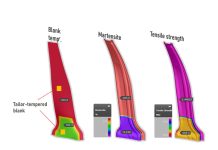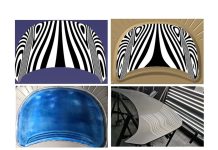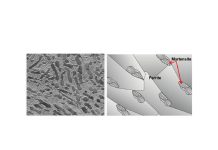Modeling of sheet metal stamping can raise many questions regarding the validity of engineering decisions based on finite element analysis. Knowing only the grade and thickness of the material modeled can still leave some open questions regarding the “known” parameters used to establish simulation. “Material Matters” is a series of posts we offer on the blog expanding the conversation on constitutive modelling of sheet metals. Click these links to see see parts two, three and four.
The behavior of metallic materials under mechanical loads has been studied extensively in the last century in almost all engineering branches. Metallic mechanical behavior can be categorized using the following descriptors: rigid, elastic, plastic and viscous. The material can be assumed to exhibit one or any combination of these properties. The behavior to be modeled is an engineering assumption that depends on the engineering application, and the necessary level of simplification or idealization for simulation.
- Rigid materials do not undergo any deformation under applied loads. Forming tools are assumed to be rigid in most sheet metal forming analyses for computational efficacy. A reasonable, although not 100% realistic assumption.
- Elastic materials undergo a reversible deformation under applied loads. Sheet metals loaded below their yield stress show elastic behavior. Observed elastic strains are due to temproary displacement of the atoms within crystal matrices, typically small for metals (0.002-0.005 or 0.2%-0.5%). Springback is, an elastic problem, as already discussed in the blog post Why is springback worse for HSS and AHSS?
- Plastic materials undergo permanent deformation that remains after the load removal. In all of the sheet metal forming processes, this behavior is desired. After all, without plastic deformation, the parts would remain as flat sheets.
- Viscous materials behavior is dependent on the rate of deformation. In hot stamping, the yield stress of the sheet metals depends on the applied strain rate.
As mentioned before, sheet materials can be idealized through any combination of these properties, depending on the application. Some widely used combinations are given in the figure below.

Material characterizations relevant to most metal forming problems
- Rigid-perfectly plastic materials will not deform until a yield stress is reached. After that point, plastic deformation occurs without a change in stress.
- Elastic-perfectly plastic materials show an elastic behavior until the yield stress is reached. After that, the behavior is perfectly plastic without a change in stress.
- Elastoplastic-hardening materials also undergo elastic deformation until yield. Beyond the yield stress, elastic and plastic deformations occur simultaneously. The stress value needed for further plastic deformation changes as the material deforms, it hardens.
- Elastoviscoplastic-hardening materials exhibit a strain-rate-dependent behavior in the plastic region. Viscoplastic material models are useful in analyzing creep and relaxation behavior, for example, in civil engineering.
In finite element simulations of sheet metal forming problems, the material is usually assumed to be elastoplastic-hardening material and the strain rate effects, when considered, are used in the definition of the flow curves. For the numerical modeling of mechanical behavior of sheet metals, the following four questions must be answered:
Question 1: How strong is the material now? Or, What is the current stress in the material?
Answer: Hardening models (stress-strain or load-displacement)
In the context of sheet metal forming, hardening can be described generally as change in the yield stress of the material with plastic deformation. This change can be assumed to be independent of the stress state or material orientation, i.e., isotropic hardening. In the case of isotropic hardening, a flow curve would be enough to describe the hardening behavior, which can be dependent on plastic strain, plastic strain rate or temperature. Isotropic hardening models cannot describe the differences in the yield stress under load reversals (Bauschinger effect) or load path changes in general. In such cases, kinematic hardening models are used.
When modeling engineering materials far in advance of production, analysts must choose carefully what hardening model is used. Characterizing the hardening behavior with a poor representation of real behavior will lead to the wrong conclusions during analysis. e.g. Using a Ludwik (Power law) extrapolation based on a the yield strength and n-value of aluminum, will lead to incorrect predictions strains and stresses during finite element analysis.
Question 2: Is the loading condition large enough to initiate or maintain plastic deformation?
Answer: Yield function models (yield surface, yield loci, yield condition, yield criteria)
At some point in the finite element iterations, calculated stress components should be compared with the current yield stress of the material. For that purpose, a scalar value is obtained from the stress components (equivalent stress) with the help of a yield function. Since this function checks, if the material flows plastically or not, it is also called yield condition or yield criteria. It can be assumed to be isotropic (von Mises yield function) or anisotropic (Hill, Barlat, or BBC yield functions). Many sheet metals are anisotropic due to the microstructure generated by cold rolling and annealing operations.
When defining the material in Finite Element Analysis, the yield function model selection will also greatly affect the veracity of the results. e.g. Using a Hill48 yield function to model aluminium would result in spurious predictions of deformation.

yield loci relate the principal stress measurements to the multiaxial deformations expected in the sheet surface
Question 3: If the material is flowing plastically, in which direction will it flow?
Answer: Flow rule

Flow rules take relate the hardening behavior to the yield criteria to predict material hardening during multi-axial deformation
Flow rule defines the relative size of the plastic strain components during plastic flow. The Levy-Mises flow rule is used commonly in the analysis of metal forming problems. One result of this rule is the normality condition. Due to this condition, the normal directions on a yield locus gains importance (or the tangents on a yield locus at a given point).
Question 4: What is the maximum deformation in the material without splitting, necking or rupture?
Answer: Formability model (forming limit curve, forming limit)
Formability of sheet metals depends mainly on the deformation state (uniaxial, biaxial, etc.). In order to capture this effect, forming limit curves are used that predict the maximum achievable strain levels before necking for different forming states. Another possibility is to use fracture criteria for specific cases such as bending over sharp radii or edge crack sensitivity.

Forming limit curves, compare computed strains with failure potential (source: kam-stampingguru.blogspot.com)
We expand the topic of yield loci, flow rules, hardening criteria, and forming limits in the second part of this post here. In the meantime further information regarding these topics can also be found:














[…] already discussed in the post “Constitutive modeling of sheet metal” there are four main components needed to model the plastic deformation of sheet metals: yield […]
[…] posts Materials Matters- “The known unknowns” and “Material plasticity visualized” covered the general aspects, common terminology, […]
I never knew that there was such detailed science in metals. It’s kind of cool to look at when there’s such a difference in materials. I wonder how people are able to come up with different materials like that.